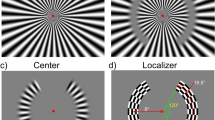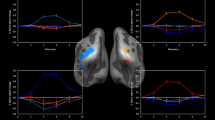Abstract
The asymmetry of the left-right and upper-lower visual field is analyzed in this paper by a model approach based on the functional magnetic resonance imaging (fMRI) blood oxygenation level dependent (BOLD) response. The model consists of the convolution between a Gaussian function and the perfusion function of neural response to stimulus. The model parameters are estimated by a nonlinear optimal algorithm, and te asymmetry of the left-right and upper-lower visual field is investigated by the differences of the model parameters. The results from eight subjects show that reaction time is significant shorter and the response is significant stronger when the lower field is stimulated than that when the upper field is stimulated. For the left and right fields, the response is different. These results provide the fMRI BOLD response evidence of the asymmetry of spatial visual fields.
Similar content being viewed by others
Rferences
Bilodeau, L. and Faubert, J. Isoluminance and chromatic motion throughout the visual field. Vision Research, 1997, 37: 2073-2081.
Birn, R.M, Saad, Z.S. and Bandettini, P.A. Spatial heterogeneity of the nonlinear dynamics in the fMRI BOLD response. NeuroImage, 2001, 14: 817-826.
Buxton, R.B., Liu, T.T and Wong, E.C. Nonlinearity of the hemodynamic response: modeling the neural and BOLD contributions. Proc. 9th ISMRM, 2001: 1164.
Casco, C.D. Spinelli, Left-right visual field asymmetry in bi-stable motion perception. Perception, 1988, 17: 721-727.
Chen, H., Yao, D., Becker, S., Zhuo, Y., Zeng, M. and Chen L. A new method for fMRI data processing: Neighborhood in-dependent component correlation algorithm and its pre-liminary application. Science in China (Series F). 2002, 45(5):373-382.
Chen, H., Yao, D., Zhuo, Y. and Chen L. Analysis of fMRI data by blind separation into independent temporal compo-nent. Brain Topography, 2003, 15(4): 223-232.
Chen, H., Yao, D. and Yang, L. An extended convolution dy-namic model of fMRI BOLD response. Neurocomputing, 2004, in press.
Christman, S.D. Local-global processing in the upper versus lower visual fields. Bulletin of the Psychonomic Society, 1993, 31: 275-278.
Christman, S.D. and Niebauer, C.L. The relation between left-right and upper-lower visual field differences. In: S. Christman (Ed.), Cerebral Asymmetries in Sensory and Perceptual Processing. Amsterdam: Elsevier, 1997.
Christman, S.D. and Niebauer, C.L. The relation between left-right and upper-lower visual field differences. In: S Christman (Ed.), Cerebral asymmetries in sensory and per-ceptual processing. Amsterdam: Elsevier, 1997.
Cohen, G. Theoretical interpretation of lateral asymmetries. In: J.G. Beaumont (Ed.), Divided Visual Field Studies of Cere-bral Organisation. London: Academic Press, 1982.
Cox, R.W. AFNI: software for analysis and visualization of functional magnetic resonance neuroimages. Comput. Biomed. Res., 1996, 29: 162-173.
Di Russo, F., Martínez, A. and Hillyard, S.A. Source analysis of event-related cortical activity during visuo-spatial atten-tion. Cerebral Cortex, May 2003, 13: 486-499.
Di Russo, F., Martínez, A., Sereno, M., Pitzalis, S. and Hillyard, S.A. Cortical sources of the early components of the visual evoked potential. HumanBrain Mapping, 2001, 15: 95-111.
Edwards, M. and Badcock, D.R. Asymmetries in the sensitivity to motion in depth: a centripetal bias. Perception, 1993, 22: 1013-1023.
Fukusima, S.S. and Faubert, J. Perceived length in the central vi-sual field: evidence for visual field asymmetries. Vision Research, 2001, 41: 2119-2126.
Friston, K.J. Bayesian estimation of dynamical systems: an ap-plication to fMRI. Neuroimage, 2002, 16: 513-530.
Friston, K.J., Mechelli, A., Turner, R. and Price, C.J. Nonlinear responses in fMRI: the balloon model, volterra kernels and other hemodynamics. NeuroImage, 2002, Volume: 12(4): 466-477.
Guillaume, M., Habib, B., Philippe, C., Me, P.I. and Jean, B.P. Robust bayesian estimation of the hemodynamic response function in event-related BOLD fMRI using basic physio-logical information. HumanBrain Mapping, 2003, 19: 1-17.
Hagenbeek, R.E. and Van Strien, J.W. Left-right and up-per-lower visual field asymmetries for face matching, let-ter naming, and lexical decision. Brain and Cognition, 2002, 49(1): 34-44.
He, S., Cavanagh, P. and Intriligator, J. Attentional resolution and the locus of visual a wareness. Nature, 1996, 383: 334-337.
Heilman, K.M. and Van Den Abell, T. Right hemisphere domi-nance for attention: the mechanism underlying hemi-spheric asymmetries of inattention (neglect), Neurology, 1980, 30: 327-330.
Henson, R.N.A., Price, C.J., Rugg, M.D., Turner, R. and Friston, K.J. Detecting latency differences in event related BOLD responses: application to words versus nonwords and ini-tial versus repeated face presentations. NeuroImage, 2001, 15: 83-97.
Hwang, K.S., Choi, Y.K. and Jung, J.S. On superior limits for the increments of Gaussian processes. Statistics & Probability Lette, 1997, 35(3): 289-296.
Kinsbourne, M The cerebral basis of lateral asymmetries in at-tention. Acta. Psychol., (Amsterdam), 1970, 33: 193-201.
Kruggel, F., Zysset, S. and Von Cramon, F.D.Y. Nonlinear re-gression of functional MRI data: an item recognition task study. NeuroImage, 2000, 12: 173-183.
Liu, H.L. and Gao, J.H. An investigation of the impulse func-tions for the nonlinear BOLD response in functional MRI. Mag. Res. Med., 2000, 18: 931-938.
Logothetis, N.K., Pauls, J., Augath, M., Trinath, T. and Oeltermann, A. Neurophysiological investigation of the basis of the fMRI signal. Nature, 2001, 412: 150-157.
Lundervold, A. and Khateeb, I.H. Numerical estimation of the BOLD response in event-related fMRI. Poster at the 25th Annual Mid-Year Meeting of the International Neuropsychological Society, 2002, July 24-27, Stockholm, Sweden.
Miller, K.L., Luh, W.M., Liu, T.T, Martinez, A., Obata, T., Wong, E.C., Frank, L.R. and Buxton, R.B. Nonlinear temporal dy-namics of the cerebral blood flow response. Human Brain Mapping, 2001, 13: 1-12.
Naito, T., Kaneoke, Y., Osaka, N. and Kakigi, R. Asymmetry of the human visual field in magnetic response to apparet motion. Brain Research, 2000, 865: 221-226.
Niebauer, C.L. and Christman, S.D. Upper and lower visual field differences in categorical and coordinate judgments. Psychonomic Bulletin & Review, 1998, 5: 147-151.
Ogawa, S., Tank, D.W., Menon, R., Ellermann, J. M., Kim, S.G., Merkle, H. and Ugurbil, K. Intrinsic signal changes accom-panying sensory stimulation: Functional brain mapping with magnetic resonance imaging. Proc. Natl. Acad Sci. USA, 1992, 89: 5951-5955.
Okita, T., Konishi, K., Morotomi, T. and Tanaka, H. Effects of selective attention to upper and lower visual-field pattern stimuli on event-related brain potentials, Jpn. J. Physiol. Psychol. Psychophysiol., 1990, 8: 81-93.
Osaka, N. Apparent motion in the upper and lower peripheral visual field. Perception, 1993, 33: S80-S81.
Previc, F.H. Functional specialization in the lower and upper visualfields in humans: its ecological origins and neurophysiological implications. Behav. Brain Sci., 1990, 13: 519-575.
Previc, F.H., Breitmeyer, B.G. and Weinstein, L.F. Discriminability of random-dot stereograms in three-dimensional space. Int. J. Neurosci., 1995, 80: 247-253.
Rieke, F., Warland, D., van Steveninck, R. and Bialek, W. Spikes: exploring the neural code. Cambridge, MA: MIT Press, 1997.
Rosen, B.R., Buckner R.L. and Dale, A. Event-related functional MRI: past, present, and future. Proc. Natl. Acad. Sci. USA., 1998, 95: 773-780.
Rubin, N., Nakayama, K. and Shapley, R. Enhanced perception of illusory contours in the lower versus upper visual hemifields. Science, 1996, 271: 651-653.
Sergent, J. The cerebral balance of power: Confrontation or co-operation? Journal of Experimental Psychology: Human Perception & Performance, 1982, 8: 253-272.
Tanabe, J., Miller, D., Tregellas, J., Freedman, R. and Meyer, F.G. Comparison of detrending methods for optimal fMRI preprocessing. NeuroImage, 2002, 15: 902-907.
Toga, W. and Thompson, P.M. Mapping brain asymmetry. Na-ture Reviews Neuroscience, 2003, 4: 37-48
Underwood, G. and Whitfield, A. Right-hemisphere interac-tions in picture-word processing, Brain Cogn. 1995, 4: 273-286.
Vogel, J.J., Bowers, C.A and Vogel, D.C. Cerebral lateralization of spatial abilities: A meta-analysis. Brain and Cognition, 2003, 52: 197-204.
von Grunau, M. and Dube, S. Visual search asymmetry for viewing direction, Percept. Psychophys., 1994, 56: 211-220.
Whishaw, I.Q. How do primates reach? Behav. Brain Sci. 1994, 17: 173-174.
Yoshizaki, K. Shift toward left visual field advantage after short term learning experience. Int. J. Neurosci., 1990, 55:113-117.
Author information
Authors and Affiliations
Rights and permissions
About this article
Cite this article
Chen, H., Yao, D. & Liu, Z. A Study on Asymmetry of Spatial Visual Field by Analysis of the fMRI BOLD Response. Brain Topogr 17, 39–46 (2004). https://doi.org/10.1023/B:BRAT.0000047335.00110.6a
Issue Date:
DOI: https://doi.org/10.1023/B:BRAT.0000047335.00110.6a




